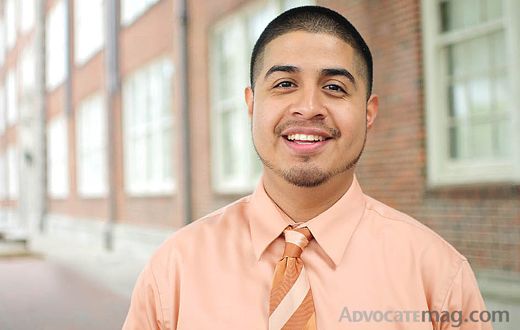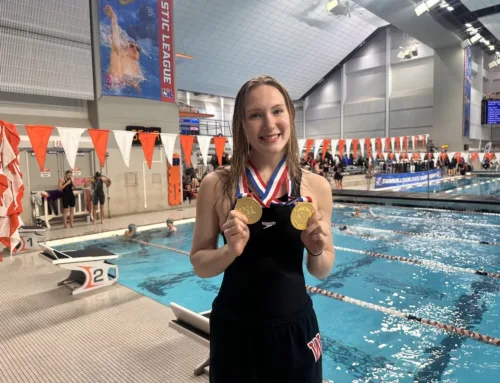High school is a time of memories, growth and learning, but most of us, if we had the opportunity, would never return to our former high schools. After graduating, we leave high school in the past and dive head first into the future.
However, several alumni have traded in their backpacks for briefcases to return to their alma maters as faculty. Read about what motivated these former students to reenter the classroom in a very different role.
Juan Rivas
History teacher and JV basketball coach
Woodrow Wilson High School, class of 2003
SCHOOL DAYS: Rivas describes himself as an “average student” in high school.
“I wasn’t an A student or necessarily the smartest kid in the class,” he says.
Rivas said a lot of his high school teachers were shocked he returned to Woodrow to teach.
“They’re like, ‘We had no idea you would ever teach,’ because I wasn’t the outspoken kid,” he says. “I was the quiet kid in the back. Now my students don’t believe me that I’m quiet.”
The journey back: After graduating, Rivas attended Lubbock Christian University, where he played on the basketball team. He was undecided on his major when his girlfriend at the time suggested he major in education. He took some classes and liked it.
“I didn’t want to want to go into business,” he says. “I didn’t want to sit in the office all day.”
After his first year, Rivas transferred to Dallas Christian College, where he also played basketball. He graduated from the school in December 2008 and emailed Woodrow’s principal, who was an assistant principal when he was a student, about teaching at the school.
He began teaching as a substitute in January 2009 and began working full-time when a position opened up in August.
“It just kind of fell into place,” he says.
What’s changed: Rivas says there have been several changes since he was a student. Woodrow students now wear uniforms.
“We just showed up wearing whatever we wanted to wear,” he says.
Rivas also says the school is “more calm” than when he was a student.
“I don’t think it is as bad now as when I was a student here,” he says. “There were a lot more fights, a lot more violence going on within the students here. A lot of drugs.”
Yet, Rivas says the culture of Woodrow remains the same.
“It’s a complete world of its own here,” he says. “You get kind of the best of both worlds. You get all the Lakewood kids, and you get all the kids from East Dallas this side of the tracks. So it’s two completely different groups of people that come to this school in the same classroom. So it’s interesting to teach them.”
NEW APPRECIATION: Many of Rivas’ high school teachers still teach at Woodrow.
“I learned how to appreciate them a lot more now than when I was here,” he says. “I used to think they just show up, tell you to do work and go home, but there’s a lot of stuff that comes with teaching, a lot of responsibility. So now that I’m in their shoes, I’m able appreciate them a lot more.”
RELATING TO STUDENTS: On the first day of class, Rivas tells his students that he attended Woodrow as a student. He says teaching at the high school he attended has been beneficial.
“I’m able to communicate more with [students], and I understand a lot of their issues,” he says. “I’m only 25, so I’m not that much older. I teach 16-, 17-year-olds.
“I’m 10 years older, so a lot of the issues they’re struggling with I struggled with, and I’m able to relate to them and understand and be a little more flexible with work and stuff like that.”
Julie McMillin
Speech teacher
Bishop Lynch High School, class of 1968
When it was grass: McMillin recalls being in fifth or sixth grade and driving with her father to a grass field across from a neighborhood. Her father told her this field is where she would be attending high school. He was an accountant and had helped with the arrangements to purchase the land.
“I saw it when it was grass,” she says. “Little did I know how much of my life I would be at Bishop Lynch.”
SCHOOL DAYS: McMillin was part of Bishop Lynch’s third graduating class. At that time, boys and girls were separated into different sections of the school.
Male and female students had separate administrations, counselors and course requirements. The long classroom hallway near Ferguson Road was the boys’ hall, and the long classroom hallway near Inadale was the girls’ hall.
McMillin says the girls knew “exactly which tile meant we were in the boys’ division.” The students had lunches, dances and pep rallies together, but during pep rallies they sat on different sides of the gym.
“The students I have now think it was really lame that we had to sit on either side of the gym,” she says.
THE JOURNEY BACK: “I knew I wanted to teach forever,” McMillin says. “I remember thinking that [Bishop Lynch] was really where I’d kind of like to teach.” After graduating from Texas Christian University, she taught at St. Philip’s in Dallas, where she attended from first to eighth grade, for two years before receiving a call about teaching at Lynch. “I was thrilled to get back here,” she says. This is her 34th year at the school.
HISTORY LESSONS: “Part of having so many alumni back is that constant connection with the history of the school,” McMillin says.
She has the opportunity to share with her students the history of traditions like the junior-senior tea.
“When I was here as a sophomore, the first class was graduating, and the girls ahead of me were going to miss their friends so they threw a party for them,” she says.
The tradition has continued and now includes a “Saturday Night Live”-style skit where the junior girls act like the girls in the senior class. “It had to start from somewhere,” McMillin says.
YEAR 34: This is McMillin’s 34th year at Lynch. “Every year, we have new kids, new teachers, new things going on in the department, but it still always feels like Lynch,” McMillin says. “It’s kind of a second home for most of us.”
Andy Zihlman
Girls varsity basketball head coach
Bishop Lynch High School, class of 1972
SCHOOL DAYS: Zihlman was the quarterback of the football team and ran track while a student.
“I enjoyed high school too much,” he says. “I wasn’t ready to leave high school yet.”
THE JOURNEY BACK: After graduating, Zihlman continued to help coach football part-time at Saint Paul School in Richardson. He worked with students of all ages, from kindergarten to eighth-grade.
“I just kind of took it and ran with it,” he says.
He graduated from East Texas State, which is now A&M Commerce, and continued coaching football, basketball and track part-time. When a full-time position opened up at Bishop Lynch in 1979, he returned to his alma mater.
WHAT’S CHANGED: Though he says the school has grown considerably over the last 10 years, “it’s like I never left.” During his time at Bishop Lynch, Zihlman has worked as a coach, dean of students, athletic director and even a driving instructor.
ALL IN THE FAMILY: Zihlman’s wife, Teena, also is a Bishop Lynch 1972 graduate, and their three children graduated from the school as well. The students “know my family well,” he says.
WHAT’S THE SAME: Zihlman enjoys being able to “practice his faith while teaching students. It’s a great blessing and great reward to work here.”







